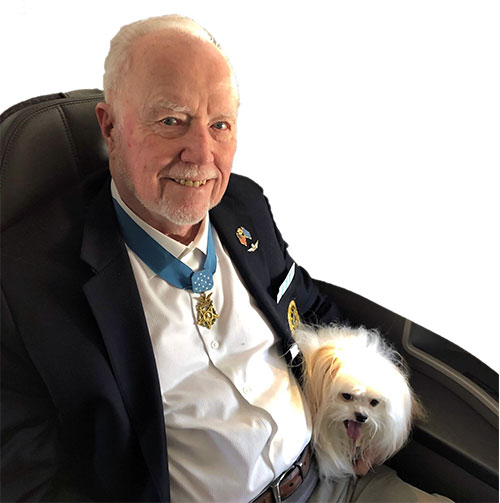Bruce Crandall
A Medal of Honor Recipient Lives Here!

In the following article, Mirabella at ASU housekeeping staff member Bill Chaplar recounts the valiant career of Colonel Bruce Crandall, a recipient of our nation’s highest medal for valor, the Medal of Honor.
Bruce was born on February 17, 1933, in Olympia, Washington. He became a high school All-American baseball star and had dreams that the New York Yankees might draft him. Instead, in 1953, the Army did. After tours in Panama and Costa Rica, he became commander of an assault helicopter battalion in South Vietnam. That was in 1965.
With fewer than eighty recipients of the Medal of Honor alive today, it’s an exclusive club. Obviously, the overwhelming majority of towns and cities do not have a living recipient of the Medal of Honor. Perhaps unknown to most of the citizens of Tempe is that one member of this exclusive club lives in their town, and he lives right here at Mirabella at ASU.
Colonel Bruce Crandall was awarded the Medal of Honor in 2007 for heroism displayed in South Vietnam on November 14, 1965, during the Battle of Ia Drang, the first major battle between the U. S. Army and the North Vietnamese Army. Col. Crandall’s heroism has been chronicled on numerous occasions. Indeed, you can search his name on Google, view YouTube videos (including one narrated by Pat Sajak!), and watch actor Greg Kinnear play Crandall in the 2002 film We Were Soldiers.
Col. Crandall’s heroic actions, combined with those of his wingman Ed Freeman (another Medal of Honor recipient) led to the evacuation of over seventy soldiers from an area under heavy enemy fire. Throughout the battle, Crandall flew twenty-two missions in an unarmed helicopter, bringing in supplies and carrying out wounded American soldiers—the latter despite the fact that medical evacuation was not part of his mission. Indeed, the landing zone had become so hot that Crandall, to continue the mission, used three different helicopters, two having been so shot up that they could no longer fly.
For those not familiar with the Medal of Honor, it is the highest medal for valor in the United States. The President of the United States awards recipients. President George W. Bush presided over Col. Crandall’s ceremony in the White House on February 26, 2007.
The award comes with several perks. For example, when he wears his Medal of Honor (which is the only medal worn around the neck), service members must salute Col. Crandall. Generals must salute Crandall, not vice versa. Medal of Honor recipients even receive salutes from Presidents.
So, how is it that I was privileged to meet such a military hero and icon? As luck would have it, I was in the Mirabella at ASU lobby when he arrived from the airport. He’d just attended an annual conference of Medal of Honor recipients. He walked through the door wearing his medal around his neck. I had to take a second look upon seeing this, because I had never seen such a medal in real life. I told Col. Crandall this. He laughed it off as if to say, “It’s really not that big a deal.” I’m sure that, over the years, it has come to be commonplace for the man wearing the medal. But, to me, an ex-infantryman, who’d never been in the actual presence of someone who’d been awarded the Medal of Honor, it was a once-in-a-lifetime event.
(William (Bill) Chaplar served ten years in the U. S. Army, five of those years in the infantry. He was stationed in Korea, at Fort Benjamin Harrison in Indiana, and at Fort Polk, Louisiana.)